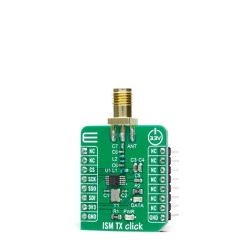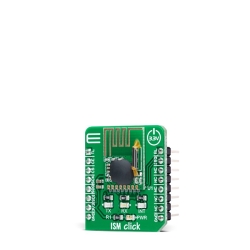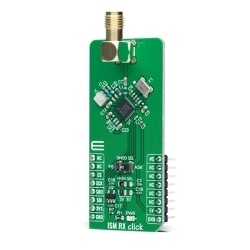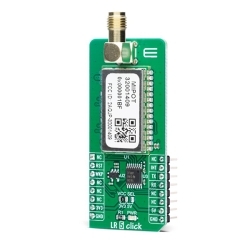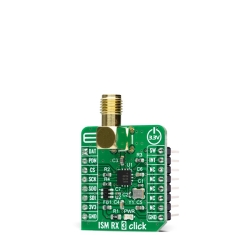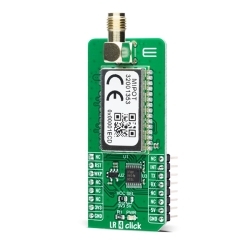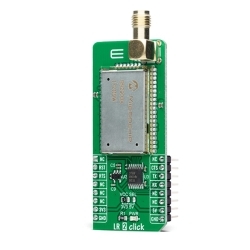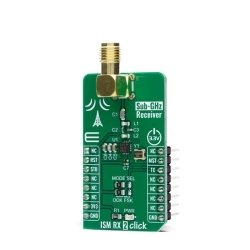MIKROE LR Click
LR Click is a compact add-on board that contains a low-power, long-range transceiver.
Product Overview
LR Click is a compact add-on board that contains a low-power, long-range transceiver. This board features the RN2483, RF technology-based SRD transceiver, which operates at a frequency of 433/868MHz from Microchip Technology. This Click board™ features an embedded LoRaWAN Class A compliant stack, providing a long-range spread spectrum communication with high interference immunity. The RN2483 module is a fully certified 433/868MHz European R&TTE directive assessed radio modem combined with the advanced and straightforward command interface. This Click board™ offers an easy and reliable solution for developing highly integrated long-range IoT networks, security systems, alarm networks, building control, M2M interfaces, and similar applications that require simple and reliable networking solutions.
LR Click is supported by a mikroSDK compliant library, which includes functions that simplify software development.
NOTE: The RN2483 module is certified for European region.
LR Click as its foundation uses the RN2483, a low-power long-range RF technology-based transceiver module from Microchip Technology. It features the Class A LoRaWAN compliant stack, optimized for robust LoRaWAN networking, immune to interferences, and suitable for long-range wireless operation. It offers a long-range spread spectrum communication with high interference immunity. A receiver with a sensitivity of -148dBm combined with the 14dBm integrated amplifier allows for extended range links that can achieve up to 15km in an open area (by the module manufacturer specification). This Click board™ offers data rates of 300kbps with FSK modulation and 5468bps with LoRa Technology modulation.
To join a LoRaWAN network, the RN2483 requires a LoRaWAN concentrator/gateway. The endpoint device has to use a unique endpoint address, an application session key, and a network session key. The first method is called over-the-air activation (OTAA), where these keys are issued after a specific join procedure. The second method is to assign these keys manually, using UART commands. This method is called activation by personalization (ABP) and can be prone to some security issues. In any case, before an end-device can communicate on the LoRaWAN network, it must be activated.
LR Click communicates with MCU using the UART interface with commonly used UART RX and TX pins, including the hardware flow control pins CTS and RTS (Clear to Send, Ready to Send) at data rates up to 57600bps for the data transfer. There are three groups of commands used to configure and operate the separate layers of the RN2483 (SYSTEM, MAC, and RADIO). Each of these layers is controlling a specific area of the module, and every UART command starts with one of the three keywords, which represent an abbreviation of the layer name they are controlling. The module is also equipped with a non-volatile memory (EEPROM) for storing the configuration settings and some additional data.
Explanation of all the configuration parameters, as well as the in-depth explanation of each feature of the RN2483 module, can be found in the Command Reference User's Guide. Please note that improper settings of some parameters might render the device unresponsive. Also, this Click board™ can be reset through the Hardware Reset pin, labeled as RST on the mikroBUS™ socket, by setting this pin to a low logic state.
This LR module integrates a very flexible transceiver offering a choice of two communication frequencies that can be used, 868MHz and 433MHz. Also, it possesses two SMA antenna connectors with an impedance of 50Ω used for connecting the appropriate antenna that Mikroe has in its offer.
This Click board™ can operate with both 3.3V and 5V logic voltage levels selected via the VCC SEL jumper. A proper logic voltage level conversion is performed by the TXB0106 voltage level shifter, while the LDO ensures that recommended values power the module. This allows for both 3.3V and 5V capable MCUs to use the UART communication lines properly. However, the Click board™ comes equipped with a library containing easy-to-use functions and an example code that can be used, as a reference, for further development.
Features & Specs
- Radio Region: Europe
- Interface: UART
- Compatibility: mikroBUS™
- Dimensions: 57.15 x 25.4mm
- Input Voltage: 3.3V or 5V
- Operating Frequency Range 1: Min. 433.050 Mhz, Max. 434.790 Mhz
- Operating Frequency Range 2: Min. 863.000 MHz, Max. 870.000 MHz
- UART interface baud rate: 57600 bps
- Operating Temperature Range: Min. -40°C, Typ. +25°C, Max. +85°C
Documentation
Customer Reviews
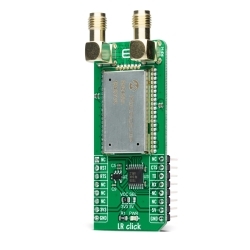
Stock and Customer Discounts
Available Discounts
- $37.95 | 25+ units
- $35.96 | 100+ units


